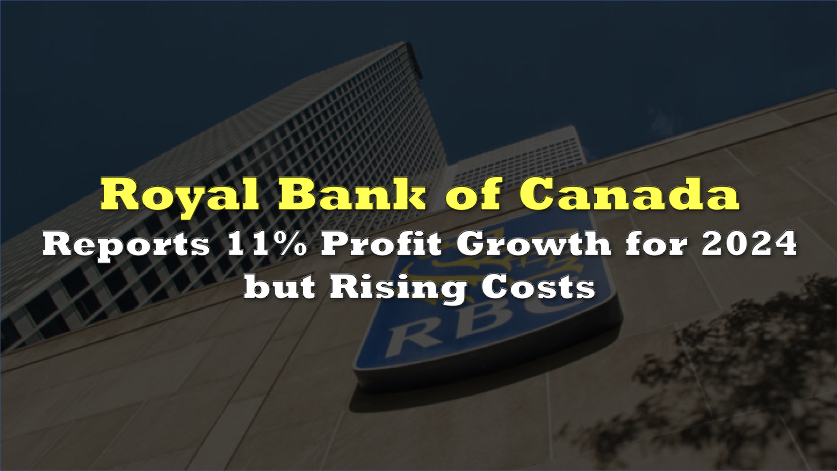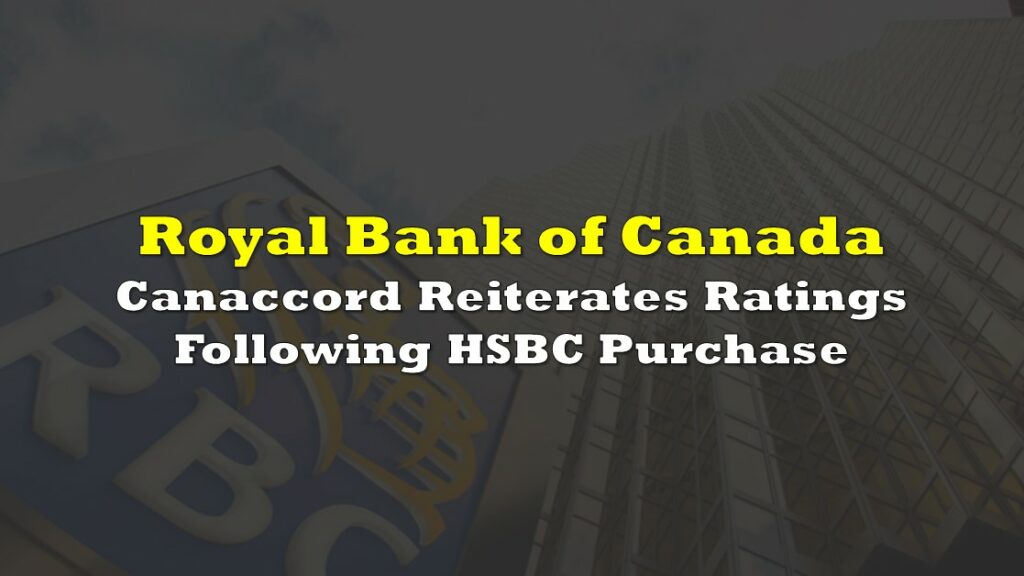The Royal Bank of Canada (TSX: RY) reported its financial performance for fiscal year 2024, posting a net income of $16.2 billion, an increase of 11% year-over-year from $14.6 billion in 2023. This growth, however, comes with caveats as rising provisions for credit losses (PCLs) and a surge in operating expenses offset some of the gains.
The year was also marked by the integration of HSBC Bank Canada, a significant acquisition that contributed $453 million to net income but also incurred substantial costs.
Diluted earnings per share rose 9% YoY to $11.25, up from $10.32 in 2023, signaling solid performance. On an adjusted basis, net income rose by 10% to $17.4 billion, while adjusted EPS grew by 8% to $12.09.
The bank’s fourth quarter results were similarly strong, with net income of $4.2 billion, a 7% increase compared to the same quarter last year. Diluted EPS for the quarter rose to $2.91 from $2.76 in Q4 2023, representing a 5% growth. However, compared to Q3 2024, net income fell by 6%, driven by higher credit provisions and elevated operating costs.
The adjusted net income for Q4 2024 was $4.4 billion, up 18% YoY but down 6% sequentially, underscoring the pressure exerted by deteriorating credit conditions in the latter half of the year.
Total revenue for the full year was $57.3 billion, an 11% increase from $51.5 billion in 2023. In Q4 alone, revenue reached $15.1 billion, up from $12.7 billion in Q4 2023 and $14.6 billion in Q3 2024. This growth was driven by strong performances in Wealth Management, Personal Banking, and Capital Markets, although the quarterly decline in Capital Markets revenues and a flattening of commercial banking growth tempered the optimism.
The HSBC Canada acquisition added $995 million to pre-provision, pre-tax earnings for the year, but the integration has not been without its costs. Total acquisition-related expenses amounted to $1.3 billion in 2024, with another $200 million anticipated in 2025. While the acquisition bolstered RBC’s market position, the integration process weighed heavily on Corporate Support, which reported a net loss of $247 million in Q4, compared to a net income of $549 million in Q4 2023.
Credit quality has emerged as a growing concern. Total PCLs for 2024 rose to $3.2 billion, a 31% increase from $2.5 billion in 2023. In Q4 2024 alone, PCLs were $840 million, up 17% from $720 million in Q4 2023 and 27% from $659 million in Q3 2024. The PCL on loans ratio climbed to 0.35% for the year, compared to 0.29% in 2023, with the Q4 figure rising to 0.35% from 0.27% in Q3 2024.
Operating expenses for the year jumped by 11% to $34.3 billion, up from $30.8 billion in 2023. In Q4, expenses rose to $9 billion, up from $8.1 billion in Q4 2023 and $8.6 billion in Q3 2024. The rise was driven by higher staffing costs, increased variable compensation in Wealth Management, and ongoing investments in technology.
Wealth Management was the standout performer, with net income surging 27% YoY to $3.4 billion in 2024. Q4 net income in this segment rose to $969 million, up sharply from $272 million in Q4 2023 and $949 million in Q3 2024. Fee-based revenue benefited from market appreciation and strong net sales, but it was accompanied by higher variable compensation costs.
Personal Banking also delivered solid results, with annual net income of $5.9 billion, up 9% from 2023. Q4 net income rose 16% YoY to $1.58 billion, but it was flat sequentially, reflecting higher credit provisions and increased expenses. Commercial Banking, by contrast, showed only modest growth, with annual net income rising 9% YoY to $2.8 billion. However, Q4 net income of $774 million represented a 5% sequential decline, driven by higher PCLs and weaker revenue growth.
Capital Markets posted a mixed performance. Annual net income grew 10% YoY to $4.6 billion, but Q4 income remained flat YoY at $985 million and fell 16% from Q3 2024. While trading activity remained robust, especially in North America, legal provisions and lower fixed-income trading revenue in Europe and Canada dragged on results.
Despite these challenges, RBC’s capital and liquidity positions remain strong. The Common Equity Tier 1 ratio stood at 13.2%, down from 14.5% in 2023, primarily due to the HSBC acquisition and risk-weighted asset growth. The Liquidity Coverage Ratio improved to 128% in Q4, up from 126% in Q3 2024, indicating robust liquidity reserves.
Shareholders were rewarded with a dividend increase to $1.48 per share, a 4% rise from last quarter, and total shareholder returns of $8.1 billion in 2024 through dividends and buybacks.
Royal Bank of Canada last traded at $175.80 on the TSX.
Information for this briefing was found via Sedar and the sources mentioned. The author has no securities or affiliations related to this organization. Not a recommendation to buy or sell. Always do additional research and consult a professional before purchasing a security. The author holds no licenses.









